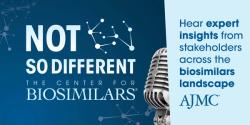© 2025 MJH Life Sciences™ and The Center for Biosimilars - Biosimilars, Health Economics & Insights. All rights reserved.
Samsung Bioepis Report Signals Turning Point for US Biosimilars
A wave of biosimilar approvals, aggressive pricing strategies, and a regulatory sea change are setting the stage for unprecedented momentum in the US biologics market, with 2025 already proving to be a landmark year in reshaping cost, access, and innovation across therapeutic areas.
The US biosimilar market continued its upward trajectory in the first quarter of 2025, driven by a potent combination of regulatory reform and competitive pricing strategies. According to Samsung Bioepis’ Q2 Biosimilar Market Report,1 the FDA's evolving regulatory posture—particularly its willingness to waive phase 3 clinical trials in certain cases—is poised to reshape the biosimilar development landscape, offering both opportunities and challenges for payers and providers.
As of March 2025, the FDA had approved 73 biosimilars across 19 reference biologics, with 48 of these (66%) launched in the US market.2 Notably, 10 new biosimilars gained approval and 7 launched in Q1 alone, including entrants for Stelara (ustekinumab), Actemra (tocilizumab), Xgeva/Prolia (denosumab), Novolog (insulin aspart), and Xolair (omalizumab).
Pricing Trends Across Therapeutic Areas
The report provided insights into biosimilar pricing under both medical and pharmacy benefits. In oncology, average sales price (ASP) discounts are particularly aggressive: 51% for trastuzumab, 53% for bevacizumab, and 65% for rituximab, all of which reflect high market penetration. Supportive care biosimilars, such as those referencing Neulasta (pegfilgrastim), also show robust discounting, with wholesale acquisition cost (WAC) reductions of up to 67% across pegfilgrastim products.
Immunology biosimilars present more varied pricing strategies. For instance, infliximab biosimilars launched with WAC discounts ranging from 19% to 59%, while new tocilizumab biosimilars display disparate ASPs with discounts of only 0.3% and 29%, respectively. Meanwhile, the ophthalmology space remains dynamic, with ranibizumab biosimilars offering 30% to 40% WAC reductions and the aflibercept biosimilar Pavblu (aflibercept-ayyh) launching at a 12% WAC discount.
Ustekinumab biosimilars stood out with WAC discounts exceeding 80%, marking a potential turning point in immunology biosimilar pricing. In endocrinology, adalimumab and insulin glargine biosimilars exhibit divergent pricing tactics, including multiple WAC options and unbranded offerings that aim to appeal to a fragmented payer landscape.
Market Share and Cost Impact
Samsung Bioepis reports significant market share gains in several categories. By Q4 2024, biosimilars captured 87% of the trastuzumab market, 90% of bevacizumab, 76% of rituximab, and 88% of filgrastim. Pegfilgrastim biosimilars held 82% market share, while slower uptake persisted in immunology and endocrinology. Notably, infliximab biosimilars reached 49% market share, adalimumab made modest gains, and tocilizumab biosimilars lagged at just 1.7%.
ASP reductions across therapeutic areas demonstrate meaningful savings. Within 5 years of biosimilar launch, ASPs decreased by an average of 53%, signaling that biosimilars are contributing to long-term cost containment.
Regulatory Evolution Offers New Opportunities
The report emphasizes the FDA’s updated biosimilar guidance, which opens the door to approvals based on robust analytical, functional, and pharmacokinetic data alone. The elimination of comparative clinical efficacy studies in some cases could slash development costs by $50 million to $225 million and shorten timelines by 1 to 2 years.
Managed care organizations should closely monitor these regulatory shifts, which could bring new competition to market faster and reshape formulary strategies. A globally aligned and efficient biosimilar development framework could also unlock access to biosimilars for biologics previously considered too complex or costly to replicate.
In a news release,3 Thomas Newcomer, vice president, head of US Commercial Operations at Samsung Bioepis, emphasized the work federal agencies are doing to improve access to biosimilars, such as potentially removing requirements for comparative efficacy studies for biosimilar approval or switching studies to obtain interchangeability.4,5
“These streamlined efforts can significantly reduce both time-to-market and development costs,” Newcomer said. “The agencies’ evolving approach is poised to accelerate biosimilar adoption, creating new opportunities for manufacturers while intensifying competition across the sector.”3
Authors of the report clearly see a future where streamlined innovation and evolving market dynamics converge to deliver greater affordability and improved outcomes. For managed care stakeholders, 2025 is shaping up to be a pivotal year in realizing the full value of biosimilars across therapeutic classes.
References
1. Samsung Bioepis biosimilar market report Q2 2025. Samsung Bioepis. April 24, 2025. Accessed May 1, 2025. https://www.samsungbioepis.com/en/etc/gadown.do?filename=SB+Biosimilar+Market+Report+Q2+2025.pdf&utm_source=pdf
2. Biosimilar approvals. The Center for Biosimilars®. Updated April 28, 2025. Accessed May 1, 2025. https://www.centerforbiosimilars.com/biosimilar-approvals
3. Samsung Bioepis’ second quarter 2025 biosimilar market report highlights US debut of ustekinumab biosimilars with WAC discounts over 80% and regulatory streamlining. News release. Samsung Bioepis; April 24, 2025. Accessed May 1, 2025. https://www.businesswire.com/news/home/20250424070511/en/Samsung-Bioepis-Second-Quarter-2025-Biosimilar-Market-Report-Highlights-US-Debut-of-Ustekinumab-Biosimilars-with-WAC-discounts-over-80-and-Regulatory-Streamlining
4. Santoro C. FDA's expanded access: from laetrile to right to try, ethical debates over early drug access. The Center for Biosimilars. April 28, 2025. May 1, 2025. https://www.centerforbiosimilars.com/view/fda-s-expanded-access-from-laetrile-to-right-to-try-ethical-debates-over-early-drug-access
5. Jeremias S. FDA draft guidance removes switching study requirements for biosimilar interchangeability. The Center for Biosimilars. June 20, 2024. Accessed May 1, 2025. https://www.centerforbiosimilars.com/view/fda-draft-guidance-removes-switching-study-requirements-for-biosimilar-interchangeability
Related Content:



